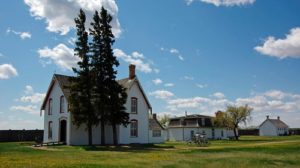In 1874 the need for law enforcement and security of Canadian sovereignty in the west led to the formation of the North West Mounted Police. In 1876 a fort was set up in Battleford overlooking the junctions of the North and South Saskatchewan Rivers. It was the first fort built by the NWMP. It was on top of the plateau, easily defensible and had good views of the surrounding area, so providing warning against possible attacks.
The original purpose of the fort was to improve relations with First Nations people. The NWMP provided protection and help during the treaty-making process and distributed the annual treaty payments to the First Nations peoples. Starvation and frustration led to grievances which were not addressed. The government began to renege on harmoniously agreed treaty arrangements. Harsh new regulations were brought in controlling many aspects of First Nations culture. This lead to increased unrest and the NWMP increasingly became involved in enforcing government policies as relationships broke down. Fort Battleford became the focal point for military operations. At the height of the unrest, it sheltered 500 local people who feared attack from the surrounding First Nations.
After the successful suppression of armed conflict between First Nations and NWMP, the government secured land claims to the west for settlement and immigration. Many First Nations prosecuted for involvement in this conflict. Six Cree and two Assiniboine men were tried for murder and publicly hanged within the walls of the stockade. Many more served time in prison.
The conditions for the First Nations did not improve. Treaty grievances remained unaddressed with stricter control over their lives and activities. They were confined to reserves and only allowed out with a signed pass. Fort Battleford maintained a strong police presence in the area.
Its importance gradually declined and it was decommissioned in 1924. Today the site contains five of the original buildings, Four contain period furniture. The stockades and bastions around the fort have been reconstructed.
The Reception area with small exhibition and good shop is in Old Government House. There are costumed interpreters around the site who give guides tours. These are well worth doing as not only are they entertaining but the staff are knowledgeable and able to answer detailed questions.
The Commanding Officer lived in a large wooden house in the centre of the site, with the officers quarters and Guardhouse near by. It had a small vegetable garden attached. It is furnished with furniture from the period and reflects the status and standing of the position of the Commanding Officer. There was a small summer kitchen attached to the side of the house. The cooking range was moved from the summer kitchen into the winter kitchen when the weather got cooler.
As well as sleeping quarters and living areas, the Officers quarters also housed the orderly room with telegraph station.
The guard house contained the cell block. Cells look generous until you realise they could hold up to six prisoners. Near by are the soldiers barracks which were basically furnished compared to the officers quarters had displays of the kit laid out ready for inspection.
Sleds were used for general transport and dog sleds in winter.
There are rifle displays during the day and the cannon is fired. at advertised times.
This was a fascinating visit which we really enjoyed. It was a glorious sunny day and it is a pleasant site. When you have finished, do go for a walk round Battleford which has many old heritage buildings along its main street.
The Parks Canada web site: www.pc.gc.ca/lhn-nhs/sk/battleford/index.aspx
Here is some history: www.virtualsk.com/current_issue/fort_battleford.html
The pictures of our visit are here.
We visited this as part of a five week trip to Canada. There is an overall report of the trip here.
I have written a series of detailed reports for some of the places visited for Silver Travel.








